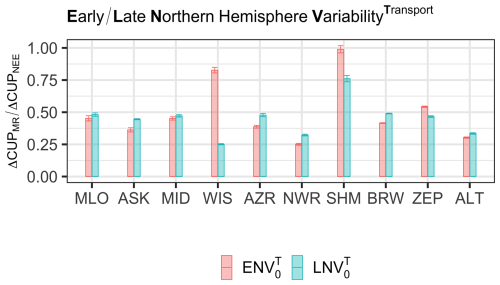the Creative Commons Attribution 4.0 License.
the Creative Commons Attribution 4.0 License.
Limitations in the use of atmospheric CO2 observations to directly infer changes in the length of the biospheric carbon uptake period
Theertha Kariyathan
Ana Bastos
Markus Reichstein
Wouter Peters
Julia Marshall
The carbon uptake period (CUP) refers to the time of each year during which the rate of photosynthetic uptake surpasses that of respiration in the terrestrial biosphere, resulting in a net absorption of CO2 from the atmosphere to the land. Since climate drivers influence both photosynthesis and respiration, the CUP offers valuable insights into how the terrestrial biosphere responds to climate variations and affects the carbon budget. Several studies have assessed large-scale changes in CUP based on seasonal metrics from CO2 mole fraction measurements. However, an in-depth understanding of the sensitivity of the CUP as derived from the CO2 mole fraction data (CUPMR) to actual changes in the CUP of the net ecosystem exchange (CUPNEE) is missing. In this study, we specifically assess the impact of (i) atmospheric transport, (ii) interannual variability in CUPNEE, and (iii) regional contribution to the signals that integrate at different background sites where CO2 dry air mole fraction measurements are made. We conducted idealized simulations where we imposed known changes (Δ) to the CUPNEE in the Northern Hemisphere to test the effect of the aforementioned factors in CUPMR metrics at 10 Northern Hemisphere sites. Our analysis indicates a significant damping of changes in the simulated ΔCUPMR due to the integration of signals with varying CUPNEE timing across regions. CUPMR at well-studied sites such as Mauna Loa, Utqiaġvik (formerly Barrow), and Alert showed only 50 % of the applied ΔCUPNEE under non-interannually varying atmospheric transport conditions. Further, our synthetic analyses conclude that interannual variability (IAV) in atmospheric transport accounts for a significant part of the changes in the observed signals. However, even after separating the contribution of transport IAV, the estimates of surface changes in CUP by previous studies are not likely to provide an accurate magnitude of the actual changes occurring over the surface. The observed signal experiences significant damping as the atmosphere averages out non-synchronous signals from various regions.
- Article
(3859 KB) - Full-text XML
- BibTeX
- EndNote
Terrestrial ecosystems constitute a net sink of carbon from the atmosphere, mediated by the interplay between photosynthesis and respiration (autotrophic and heterotrophic). The period between the dates when an ecosystem transitions from being a carbon source to a carbon sink and vice versa is referred to as the carbon uptake period (CUP) (Gonsamo et al., 2012). During the Northern Hemisphere's CUP, a continuous decline can be observed in atmospheric CO2 mole fraction in many sites across the globe. The CUP as defined by net ecosystem exchange (NEE) will be referred to as CUPNEE, and the corresponding period in the CO2 mole fraction data will be referred to as CUPMR. The timing and duration of the CUPNEE and CUPMR are influenced by vegetation phenology and soil respiration, which are in turn influenced by climate variability (Gill et al., 2015; Piao et al., 2019). For example, in northern boreal and temperate ecosystems, warmer temperatures trigger early snowmelt and an associated early onset of plant growth in spring (Buermann et al., 2018; Zhou et al., 2020). In autumn, warm temperatures lead to delayed leaf senescence and a longer growing season (Piao et al., 2019; Shen et al., 2022). However, warmer temperatures can also enhance soil respiration if soil moisture is not limiting, and potentially result in earlier termination of the CUPNEE and CUPMR (Piao et al., 2008). The timing of the CUPMR integrates the signal of ecosystem changes over large spatial scales. Metrics associated with CUP, e.g., its amplitude, have been attributed to Northern Hemisphere greening (e.g. Forkel et al., 2016; Keeling et al., 1996; Barichivich et al., 2013) and to the intensification of the land carbon sink over the past decades (e.g. Graven et al., 2013; Ciais et al., 2019).
In previous studies (e.g. Fu et al., 2017, 2019), the CUPNEE has been derived from eddy-covariance measurements of net CO2 fluxes. However, estimation of the CUPNEE using eddy-covariance flux measurements remains challenging on a global scale due to the uneven distribution of flux towers over the globe and the small spatial area covered by the footprint of these towers (Jung et al., 2020; Walther et al., 2022). Therefore, several studies have explored the potential of remote sensing to estimate the CUPNEE (Churkina et al., 2005; Zhu et al., 2012; Gonsamo et al., 2012). However, while satellite-based indices provide information about the overall health and activity of vegetation, they cannot distinguish between different components of the carbon cycle, such as gross primary production and ecosystem respiration. In drought-stressed ecosystems, there may even be periods of carbon release during the growing season (Churkina et al., 2005; Zhu et al., 2012; van der Woude et al., 2023), influencing CUPNEE. The satellite-based indices are closely related to vegetation growth or photosynthesis and characterize the start and end of the growing season (Wang et al., 2022; Zeng et al., 2020), but they do not necessarily capture CUPNEE.

Figure 1Map showing the location of studied sites, with the station names corresponding to the station code shown in the map.
Measurements of atmospheric CO2 dry air mole fraction from remote background sites represent the balance between surface emissions and uptake from land and ocean (Keeling et al., 1996) over large spatial scales. The seasonal patterns evident in these data from the Northern Hemisphere reflect the terrestrial ecosystem exchange, mostly from the high and mid-latitudes, and have been used by previous studies to investigate the changes in the CUPNEE over large spatial scales (e.g. Barichivich et al., 2012; Piao et al., 2008, 2017). Robust methods were developed for the estimation of the CUP from the CO2 mixing ratio, such as the ensemble of first derivative (EFD) method from Kariyathan et al. (2023), which was better able to identify changes in the CUPNEE compared to the conventional use of the dates when the detrended seasonal cycle crossed the zero value. Even with refined CUPMR estimation methods, atmospheric transport causes a significant fraction of observed CO2 variations at surface stations. Interannual variations and long-term trends in atmospheric transport can affect the relationship between the seasonal cycle of atmospheric CO2 observations and surface exchange (Murayama et al., 2007; Piao et al., 2008). For example, Jin et al. (2022) studied the impact of varying winds and ecological CO2 fluxes on seasonal cycle amplitude trends, finding that shifting winds partially offset the amplitude increase at Mauna Loa (MLO), contributing nearly 50 % to the seasonal cycle amplitude changes between 1959 and 2019. Lintner et al. (2006) suggest a contribution by atmospheric transport to the downward trend in the CO2 seasonal cycle amplitude observed at MLO between 1991 and 2002. Murayama et al. (2007) demonstrated how year-to-year changes in atmospheric transport create significant interannual variations in the downward zero-crossing date of the CO2 seasonal cycle, inevitably influencing CUPMR estimates. Previous studies have primarily focused on aspects such as the seasonal cycle amplitude or zero-crossing times. Barlow et al. (2015) used the improved CUP estimation method to explore the influence of transport on CUP timing to some extent. In this study, we aim to understand in detail how well the CUPMR deduced from atmospheric time series observations of CO2 mixing ratios represents the CUPMR changes from the Northern Hemisphere biosphere and its interannual variability (IAV), especially:
-
To what extent do CO2 mixing ratio observations accurately capture variations in CUPNEE?
-
How does IAV in atmospheric transport affect the observed changes in CUPMR?
-
Considering the variability in both CUPNEE and transport, can CUPMR effectively reflect long-term trends in CUPNEE?
-
Can the changes observed at the studied sites be attributed to specific regions of the Northern Hemisphere?
To address these questions, we evaluate the role of transport in shaping the CUPMR at regional and global scales by conducting a series of experiments using the atmospheric transport model TM3 (Heimann and Körner, 2003) for a total of 10 sites in the Northern Hemisphere (Fig. 1).
To evaluate the degree to which CUPMR represent the changes in the CUPNEE, when influenced by atmospheric transport, we design idealized scenarios with prescribed changes to the optimized NEE fluxes from the Jena CarboScope Atmospheric CO2 Inversion (Rödenbeck et al., 2003) (version ID: sEXTocNEET_v2021). The modifications were applied solely to pixels in the Northern Hemisphere (> 0° N) with a clearly defined seasonal cycle, characterized by a seasonal cycle minimum, and downward and upward zero-crossing points in spring and autumn, respectively. The year 2003 is employed as the reference year (simulations with an alternative reference year, 2001, did not show a noticeable difference), and pixels exhibiting clearly defined seasonal cycles in that specific year were chosen for perturbation. For the remaining pixels, the reference year flux was repeated over time, so that there was no IAV in CUPNEE. This was done to ensure that any observed changes in the simulated CO2 mixing ratio could be attributed to the prescribed Δ. The influence of fossil fuel, biomass burning, and ocean fluxes on the seasonal variation of atmospheric CO2 is minimal, and changes in the seasonal cycle of atmospheric CO2 reflect alterations in the integrated net ecosystem exchange in the Northern Hemisphere (Barichivich et al., 2012). While these fluxes were not modified in our simulations, our results are based on differences between simulations where only the NEE flux is altered. The flux manipulation was carried out from 1995 to 2017, aligning with the meteorological forcing used in the transport model. These adjusted fluxes were then transported forward using an atmospheric transport model, TM3 (Heimann and Körner, 2003), simulating time series of CO2 mixing ratios at different study sites (as shown in Fig. 1), in temporal frequency aligning with the flask measurements at the sites. The 10 sites chosen for this study represent a selected subset of the Northern Hemisphere observation network. To minimize anthropogenic influences, only remote background sites were included. These sites were selected based on their long-term data records and their spatial distribution across the Northern Hemisphere, with roughly at least one station per 10° latitude, capturing the network's spatial diversity. Previous studies, such as Murayama et al. (2007) and Piao et al. (2008), have confirmed that interannual variations and long-term trends in atmospheric transport can affect the relationship between the seasonal cycle of atmospheric CO2 observations and surface exchange. These studies also used a subset of background sites to evaluate transport influence on observed signals, similar to our approach. After the forward transport run, we assess CUPMR changes based on the simulated CO2 mixing ratios (ΔCUPMR) resulting from ΔCUPNEE. We use the EFD method from Kariyathan et al. (2023) to evaluate CUPMR, as its efficacy on the sites shown in Fig. 1 was previously established in Kariyathan et al. (2023). The method uses an ensemble-based approach to quantify the uncertainty associated with curve-fitting discrete time series data and deriving seasonal cycle metrics. Using this approach, an optimal threshold is defined based on the first derivative of the CO2 seasonal cycle to determine CUP timing. The threshold is selected such that the CUP timing closely corresponds to the spring maximum and late summer minimum, with minimal influence from curve-fitting uncertainty caused by multiple or broader peaks in the CO2 seasonal cycle.
Table 1Description of different forward simulation experiments using manipulated NEE fluxes. The first character in the experiment name indicates if the early (E) or late (L) CUPNEE phases are manipulated, the next character specifies if Northern Hemisphere (N) or Regional (R) fluxes are adjusted, and the subscript and superscript of the last character denote variability (V) in CUPNEE and transport, respectively. The Δ applied in each experiment is shown in the first column. In CUPNEE, x ranges from −10 to +10 d in intervals of 2 d. In CUPNEE, x can be a sequence from −10 to +10 d and vice versa denoted by p and n, respectively, in the main text.
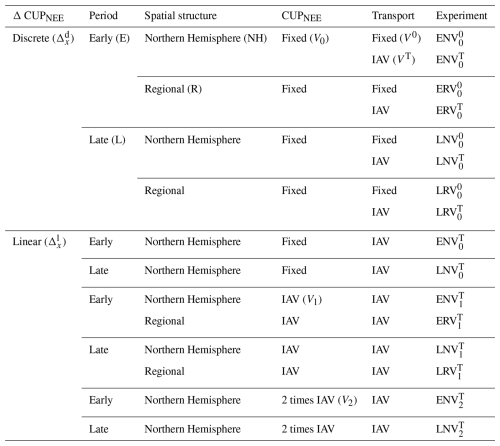
To evaluate how well CUPMR captures the changes in CUPNEE, we used experiments and , where we imposed spatially uniform, discrete changes in CUPNEE (Δd) and the atmospheric transport was held constant in the forward transport run (meaning that one year (2008) of transport was repeated). Then, to answer how the IAV in atmospheric transport affects derived CUPMR, the CO2 mixing ratios were simulated with interannually varying meteorology (experiment and ). To evaluate the ability of CUPMR to reflect long-term trends in CUPNEE, we initially assessed the ability to capture a trend in CUPNEE while accounting for IAV in atmospheric mixing. This was achieved by prescribing long-term trends in CUPNEE (Δl) and conducting the forward transport run with interannually varying meteorology. Subsequently, we then tested the detectability of prescribed linear trends in CUPNEE (Δl) when IAV was present in both atmospheric transport and NEE (experiments and ). Additionally, to analyse the influence of IAV in CUPNEE, we prescribed known IAV to CUPNEE (experiments and ). Further, to understand the sensitivity of the simulated signals to regional changes (experiments , , , and ), we limited the flux manipulation to Northern Hemisphere land regions of the TransCom3 (Gurney et al., 2002) experiment, namely Europe, Eurasian Temperate, Eurasian Boreal, North American Temperate, and North American Boreal. The experiments performed are listed in Table 1.
2.1 NEE flux manipulation
The CUPNEE is the period when the NEE flux is negative, and the downward and upward zero-crossing dates represent the onset and termination of the CUPNEE, respectively. Hence, we shift the NEE zero-crossing dates to have a change Δ (where Δ is measured in days) in the CUPNEE duration (ΔCUPNEE). The NEE flux is characterized by daily temporal resolution, showing relatively gradual variations along the y-axis compared to the x-axis. For all the experiments performed, the NEE values (i.e., y-axis) are modified to achieve the desired timing adjustments (Δ) in CUPNEE without altering the time axis itself. This adjustment ensures the creation of a smooth curve that closely mirrors the actual flux while achieving the intended change in CUPNEE. For each value of ΔCUPNEE, we modify the downward and upward zero-crossing dates of NEE separately to evaluate the effect of changes in the early and late CUPNEE phases, respectively. This is achieved by adding or subtracting a continuous curve to the period extending from the peak in spring to the NEE minimum for early phase changes and the period from the NEE minimum to peak in winter for late phase changes. The curve is created by combining two distinct half-Gaussian curves (Fig. 2, red and blue curves): the first curve has its peak at the new onset/termination and a standard deviation (σ1) equal to one-third of the distance between the NEE peak in spring/winter and the new onset/termination. The second curve, also with its peak at the new onset/termination, has a different standard deviation (σ2) equal to one-third of the distance between the new onset/termination and the date corresponding to the NEE minimum value. This configuration (i.e., Gaussian peaks and σ) ensures that the Gaussian tail minimizes any shift around the NEE peak and trough while realizing the Δ shift at the onset or termination of the CUPNEE.
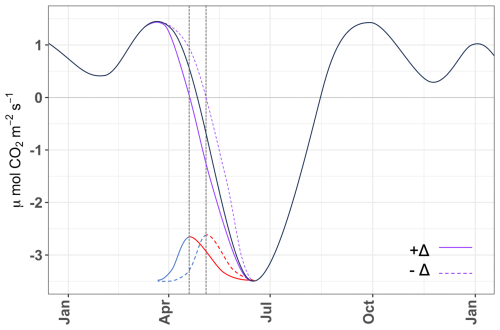
Figure 2Schematic showing manipulation of CUPNEE. The shifted purple solid/dashed curves result in +Δ and −Δ changes in the CUPNEE, respectively. The curve is obtained by subtracting/adding two half-Gaussian curves. For example, the red and blue curves combine at the points (i.e., new onset) indicated by the dashed black lines to produce the purple curves (described in Sect. 2.3). The seasonal cycle minimum separates the early (left) and late (right) CUPNEE phases. The manipulation for the early CUPNEE phase is shown here and can be similarly applied to the late CUPNEE phase.
Some pixels exhibit a distinct seasonal pattern without a well-defined peak in spring or winter. In those cases, the period for manipulating the early and late CUP phases then extends from the beginning of the year to the day of minimum NEE and from the day of minimum NEE to the end of the year, respectively. The portions of the first and second curves corresponding to the range from “μ−3σ1” to “μ” and from “μ” to “μ+3σ2”, respectively, are then combined and smoothed using a spline function (Fig. 2, purple curves).
We note that the annual flux is not conserved in the manipulation. However, we detrend the simulated CO2 mixing ratio prior to CUPMR analysis, which would remove any trend in the CO2 mixing ratio caused by repetition of the manipulated years. Further, when evaluating the simulated CO2 time series, we found that the change in the total annual flux only changes the peak-to-peak amplitude and does not influence the timing and duration of the simulated time series, except at times corresponding to periods of manipulation in the CUPNEE. This happens, for instance, when the downward zero crossing of the NEE flux is manipulated: it changes only the CUP onset and has minimal influence on the CUP termination in the CO2 mixing ratios. The different cases of manipulation are described below.
-
: In these simulations, every year has the same discrete change in CUPNEE. In the different experiments, the magnitude of the shift (denoted by x) ranges from −10 to 10 d in intervals of 2 d.
-
: In these simulations, ΔCUPNEE progresses from −10 to +10 d (denoted by x=p) or vice versa (denoted by x=n) over the period of manipulation.
Manipulation is done for experiments where there is no IAV in CUPNEE, indicated by V0 in the experiment name. manipulation is made for experiments with and without IAV in CUPNEE (i.e., experiment names with V0, V1, and V2). For the case V0, the manipulation is done on the flux of a reference year (2003 chosen arbitrarily), which is repeated in time so that there is no IAV in CUPNEE. Any IAV in CUPMR may then be attributed to IAV in transport. In V1, the annual fluxes are used instead of repeating the base year flux. The case V2 has a prescribed IAV in CUPNEE. In this case, for a given pixel, a set of Δ values is added to the original CUPNEE in the manipulation period (2000–2017). The set of Δ has a mean zero and a standard deviation twice that of the IAV in the original CUPNEE for the manipulation period.
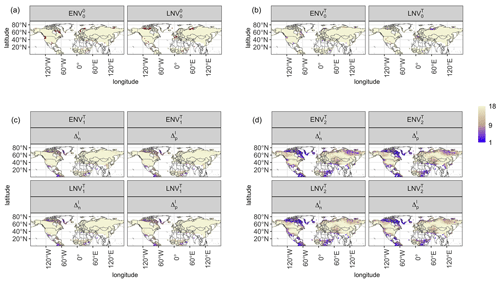
Figure 3Spatial distribution of the pixels manipulated for different experiments. (a) Reference year flux is repeated and discrete changes are prescribed to CUPNEE (beige), the red colour represents pixels where Δ is different from the prescribed Δ due to the complications described in Sect. 2.1. (b) Reference year flux is repeated and a long-term trend is applied to CUPNEE. When a long-term trend is applied, Δ varies over the years. The colour bar indicates the number of years for which Δ equals the prescribed Δ, i.e., years with no complications described in Sect. 2.1 (also applicable for panels (c) and (d)). (c) Actual CUPNEE is retained and long-term trend is applied to CUPNEE. (d) IAV in CUPNEE is doubled and a long-term trend is applied. The panel titles in every plot represent different simulations as detailed in Table 1.
The flux alteration is complicated to apply in some cases, as described below.
-
When a local maximum is observed between the downward or upward zero-crossing points and the minimum NEE. In such cases, adding the Gaussian curve shifts these peaks above the zero-crossing line, creating an additional downward or upward zero-crossing point. This complicates the assessment of CUPNEE following the manipulation, and results in ΔCUPNEE being different from the prescribed value. The Δ is kept at zero in this case.
-
In a few instances, when the magnitude of Δ is larger than the period between the original zero-crossing dates and the start/end of the period of manipulation, we instead opt for the next-closest Δ value in the sequence.
-
Additionally, in manipulation cases where interannually varying fluxes are used (), only certain years have the complexities described above. In such instances, the next available Δ value from the sequence is chosen to minimally impact the imposed CUPNEE trend. This involves selecting a Δ such that it results in a smaller or larger value compared to the subsequent year, achieving either a positive or negative change in CUPNEE (i.e., or CUPNEE).
The manipulated pixels for the different cases are shown in Fig. 3. Furthermore, the manipulated fluxes are used to conduct regional sensitivity analyses, in which we limit the flux manipulation process explained above to different TransCom3 (Gurney et al., 2002) geographic regions in the Northern Hemisphere. This allows us to evaluate the regional contribution of NEE fluxes to ΔCUPMR when comparing how perturbations involving different regions are expressed in CUPMR at the studied sites. This comparison is conducted for two experiments: , illustrating the integration of signals from various regions in an idealized scenario without IAV in atmospheric transport or CUPNEE; and , which reflects signal integration in a relatively realistic setting, with IAV in atmospheric transport and CUPNEE.
2.2 Forward transport runs
We use a three-dimensional global atmospheric transport model, TM3 (Heimann and Körner, 2003), to simulate CO2 mixing ratios at the specified sites based on manipulated NEE fluxes. The model is run at a spatial resolution of 5° in longitude and 4° in latitude with 19 vertical levels, using 6-hourly NCEP reanalysis meteorological fields from 1995 to 2017 and daily surface fluxes from the Jena CarboScope CO2 Inversion (version ID: sEXTocNEET_v2021) (Rödenbeck et al., 2003), with the NEE fluxes manipulated as previously described. The forward runs are carried out with (1) fixed transport (meteorology from a random year, here we used the year 2008 and repeated it in time such that there is no IAV) and (2) interannually varying transport for the period 1995 to 2017 to study the contribution of atmospheric transport to the IAV in CUPMR. The first five years are excluded from the CUPMR analysis to account for the model's spin-up time, and ΔCUPNEE is held at zero during this period.
2.3 CUP estimation methods
The forward transport runs simulate CO2 mixing ratios at discrete time steps, which we sample at the frequency corresponding to the flask measurements (approximately bi-weekly) at the studied sites. This sampling interval sufficiently captures the larger-scale trends and seasonal variations critical to our analysis and allows for consistent comparison with previous studies that looked into long-term trends using flask measurements. We apply the EFD method described in Kariyathan et al. (2023) to the output data and estimate the CUPMR. Here, the CUPMR is estimated using a threshold derived from the first derivative of the detrended and smoothed CO2 mixing ratio seasonal cycle curves. A threshold of 15 % and 0 % of the first-derivative minimum was used as a threshold to determine the onset and termination of the CUPMR, respectively, as in Kariyathan et al. (2023). The calculation is applied to an ensemble of the detrended time series, which allows for an uncertainty range on the CUP estimate to be calculated.
3.1 Northern Hemisphere CUPMR sensitivity under fixed transport
The calculated ΔCUPMR consistently shows lower absolute values than the prescribed ΔCUPNEE. For example, at BRW, ΔCUPMR is 0.43 times the prescribed early phase ΔCUPNEE as illustrated in Fig. 4a. This reduction in ΔCUPMR is found across all the studied sites with varying degrees of intensity, as illustrated in Fig. 4d, when Δ is prescribed to either the early or late phases of CUPNEE. This shows how atmospheric observations respond differently to CUP perturbations compared to local NEE measurements, and a one-on-one translation might lead to an incorrect interpretation of at least the magnitude of CUP changes. The persistent difference in the magnitude of ΔCUPMR from the imposed ΔCUPNEE results from the integration of signals from various regions with different CUPNEE timings as detailed in Sect. 4.
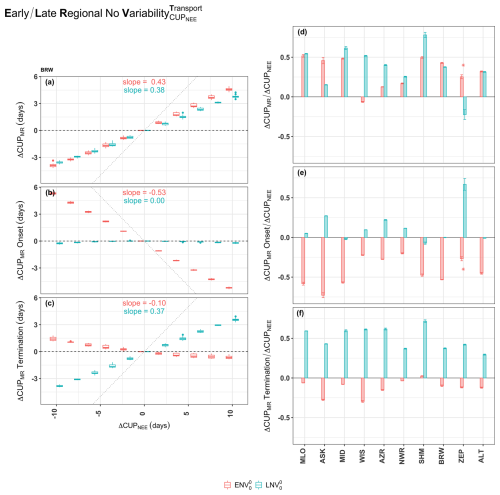
Figure 4The change in CUPMR in response to varying ΔCUPNEE for experiments (red) and (cyan). The experiments and largely drive the Δ in CUPMR onset and termination, respectively, and thereby ΔCUPMR. The left panels show the Δ in (a) CUPMR (i.e., the duration), (b) CUPMR onset, and (c) CUPMR termination against the applied ΔCUPNEE for BRW. In these panels, the individual boxplots display the distribution of the median values across years, estimated from the ensemble spread for each year. The dotted line represents an ideal case of a one-to-one (minus one-to-one for panel (b)) relation between ΔCUPNEE and ΔCUPMR. The text within these plots shows the slope of the regression lines fitted to the median of the boxplots. The right panels (d–f) show these slopes (unitless) across the different studied sites. The estimate of ZEP is reduced to 0.1 times the actual value for ease of visualization. Error bars represent ±1 standard deviation (σ) around the estimated slope.
At most studied sites, the Δ assigned to the early phase of CUPNEE predominantly affects the onset of CUPMR (Fig. 4b and e). The ΔCUPMR then corresponds to the changes in onset of CUPMR as indicated by the similar variation in the red bars in Fig. 4d and e. Similarly, Δ applied to the late phase of CUPNEE primarily influences the termination of CUPMR (Fig. 4c and f) which then drives ΔCUPMR in experiment (Fig. 4d and f, cyan bars). This suggests that the changes in the early and late phases of CUP at the surface can be analysed separately by examining the onset and termination of CUP inferred from CO2 mole fraction observations. Contrary to the direct but dampened relationship between ΔCUPNEE and ΔCUPMR, we find an opposite response at some sites: a lengthening (shortening) imposed on CUPNEE leads to shortening (lengthening) of the CUPMR. This is seen to occur at sites ZEP and WIS, as indicated by the negative slopes at these sites (Fig. 4d).
At ZEP, the late phase ΔCUPNEE leads to unintended changes in CUPMR onset. For Δ prescribed to the late CUPNEE phase, the change in CUPMR termination is only 0.4 times the Δ, while that in the onset is 0.6 times the Δ. Thus, the changes intended for CUPMR termination extend to CUPMR onset in the following year. For example, a 10 d delay prescribed to the CUPNEE termination results in a 4 d delay in CUPMR termination and a 6 d delay in the onset. This results in a 2 d shorter CUPMR, establishing an inverse relation between ΔCUPMR and ΔCUPNEE at ZEP (slope of −0.22 in the experiment ). Likewise, at WIS, in experiment , the change in CUPMR onset is only −0.2 times the applied early phase ΔCUPNEE, while the change in termination is −0.3 times the perturbation imposed. This offsets the ΔCUPMR and leads to a significant (p < 0.001) inverse relation between ΔCUPMR and ΔCUPNEE at WIS (slope of −0.06, in the experiment).
3.2 Northern Hemisphere CUPMR sensitivity under interannually varying transport
Even when interannual variations from atmospheric transport are included, changes imposed in ΔCUPNEE are reflected in ΔCUPMR. The varying atmospheric transport leads to year-to-year variations in signal integration and changes that were not captured in the experiment with transport from single-year meteorology can be seen in the experiment with interannually varying transport. This is illustrated for different sites in Fig. 5. An inverse relation between ΔCUPMR and ΔCUPNEE was calculated at WIS and ZEP in experiments and , respectively, as described in Sect. 3.1. However, in experiments with varying transport, slope values of 0.83 at WIS (experiment ) and 0.47 at ZEP (experiment ) are found, compared to −0.06 and −0.22 in the experiment with fixed transport. This suggests that anomalies observed in specific years may be predominantly attributed to the meteorological conditions of those particular years.
3.3 Northern Hemisphere CUPMR sensitivity to long-term trends in CUPNEE
Out of all the evaluated sites, only SHM and BRW partially captured CUPMR trends corresponding to the imposed trends in CUPNEE as shown in Fig. 6 (results for other sites are shown in Table A1). In experiment , the largest trend in CUPMR is derived at SHM, with values of 0.5 and −0.3 d yr−1 for the imposed increasing (1.11 d yr−1) and decreasing (−1.11 d yr−1) trend, respectively. Similarly, in experiment , the largest trend in CUPMR is observed at BRW (0.5 and −0.2 d yr−1 for the imposed increasing and decreasing trend, respectively). Nevertheless, part of the observed trend can be attributed to the IAV in atmospheric transport, thereby showing that the IAV in transport can influence our understanding of the actual long-term changes in CUPNEE trends. This can be seen in Fig. 6, green bars (), corresponding to experiments and . Note that in these experiments, there is no IAV in the CUPNEE flux as indicated by the subscript “0”, and indicates that no trend is prescribed to the CUPNEE. Then any derived CUPMR trend can be attributed solely to the IAV in transport. The trend from the IAV in transport contributes to the asymmetry between the red and blue bars. At BRW, experiment , indicates that a CUPMR trend of 0.1 d yr−1 can arise from variability in transport alone, and accounts for about 20 % of the derived CUPMR trend (blue bar showing 0.5 d yr−1).
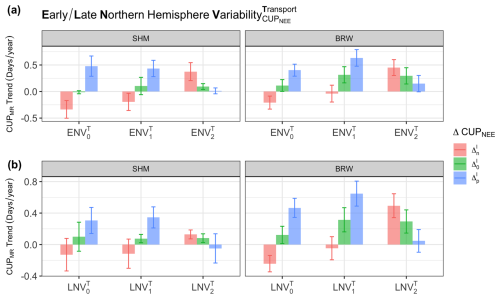
Figure 6Sensitivity of CUPMR to the applied long-term trend in CUPNEE (results for sites SHM and BRW). The bars show the slope of the regression line fitted to the median CUPMR from experiments (a) and (b), where x is 0, 1, and 2 implying no IAV in NEE flux, the actual IAV in NEE flux, and two times the actual IAV in NEE flux, respectively. Error bars represent ±1 standard deviation (σ) around the estimated slope. Colours show the prescribed trend (1.1 d yr−1) in blue, (−1.1 d yr−1) in red, and (0 d yr−1) in green applied to CUPNEE.
Furthermore, we observe that the actual IAV in the CUPNEE fluxes contribute to the derived CUPMR trends; however, as the IAV in the flux becomes larger, it imposes noise that makes the trends harder to detect. This is shown in experiments and (Fig. 6), where the actual IAV in CUPNEE is retained and doubled, respectively. In experiment , the CUPMR trend in response to the prescribed opposite trends, and are distinct in sign. Even though the magnitude of the prescribed trend is the same, a large difference in magnitude can be seen between results for (red bar, 0.6 d yr−1) and (blue bar, −0.03 d yr−1), for example, at BRW. This can be attributed to the increasing trend from both IAV in the actual flux and transport, as indicated by the green bar for . The green bars in experiment (0.3 d yr−1) and (0.1 d yr−1) are distinct, and their difference (0.2 d yr−1) is the contribution from the actual IAV in CUPNEE alone. In the experiment where the IAV in CUPNEE per pixel was doubled, it becomes evident that the imposed alterations in CUPNEE are not accurately reflected in CUPMR, even at sites like BRW, which exhibited pronounced responses in other experiments ( and ).
3.4 Regional contribution to CUPMR
The various Transcom3 regions of the Northern Hemisphere contribute in various degrees to the CUPMR changes observed at the studied sites. The changes in the Boreal regions are partially captured at both the higher and lower latitudes (e.g., ALT, BRW, SHM, MID, and MLO). Considering both the early and late ΔCUPNEE phases, the contribution from the Eurasian Boreal region is largely seen at SHM (−3 d in the early and −7 d in the late CUPNEE phase), followed by MID with (−3 in both the days early and late CUPNEE phase), showing an eastward transport from the Eurasian Boreal region. Similarly, considering both the CUPNEE phases, the contribution from the North American Boreal region is seen at all sites except ASK, WIS, and ZEP. In response to delayed onset, prescribed to the CUPNEE in Eurasian Boreal region, a longer CUPMR is calculated at ASK, WIS, and AZR (Fig. 7a), suggesting that the inverse slope relation between ΔCUPMR and ΔCUPNEE in Sect. 3.1 might largely be from changes in the Eurasian Boreal region. In the Eurasian Temperate region, the Δ prescribed to both the early and late CUPNEE phases integrates at the lower latitude site (e.g., MID, MLO, NWR, and, SHM), whereas higher-latitude sites (e.g., ALT, BRW, and ZEP) only capture perturbations imposed during the early phase of CUPNEE. The contribution from the North American Temperate region is strong during the early phase of CUPNEE, while late phase changes are captured only by MID and AZR. Signals from the European region integrate well at most of the studied sites. At ZEP, a significant regional contribution from any of the studied TransCom3 regions can only be seen in the early CUPNEE phase. This explains to some extent the direct relation between ΔCUPMR and ΔCUPNEE found only in the early phase (Sect. 3.1).
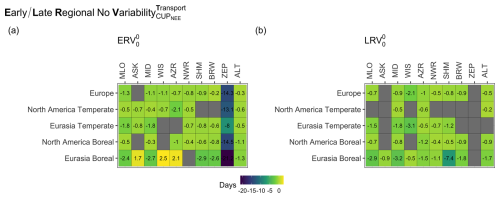
Figure 7Regional contribution to ΔCUPMR. The colour and value represent the ensemble median of ΔCUPMR when ΔCUPNEE is −10 d, in experiments (a) and (b). Values are displayed solely for the sites where a significant difference in ΔCUPMR is detected when ΔCUPNEE is 0 and −10 d (p-value of Mann–Whitney test < 0.05) in the specific region (y-axis).
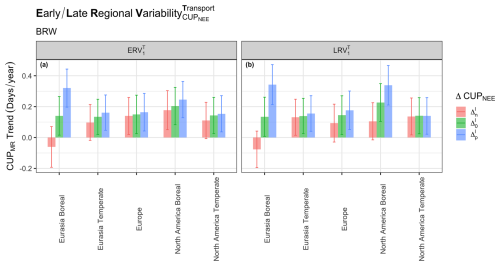
Figure 8Regional contribution to CUPMR trend detected at BRW in response to imposed long-term CUPNEE trends. The bars show the slope of the regression line fitted to median CUPMR from experiments (a) and (b). Error bars represent ±1 standard deviation (σ) around the estimated slope. The colours represent the trend in NEE imposed in the experiment, as described in Fig. 6.
The long-term trend in the CUPMR could not be accurately attributed to different regions even for sites like BRW that showed a predominant response to the prescribed long-term trend in CUPNEE (Sect. 3.3). This can be seen from Fig. 8. At BRW, the CUPMR trends partially reflect the CUPNEE trends prescribed to the Eurasian Boreal region. For example, in the early CUPNEE phase, we find a change of 0.32 and −0.06 d yr−1 in response to the prescribed (1.1 d yr−1) and (−1.1 d yr−1), respectively. However, the large error bars show that the uncertainty in trend estimation is large when changes are prescribed to only a given TransCom3 region.
We find that changes (both fixed differences and trends) prescribed to CUPNEE are reflected in CUPMR simulated by TM3. However, the magnitude of the change seen in CUPMR is consistently lower than the prescribed change in CUPNEE, for example at BRW only about 50 % of the change applied to CUPNEE was reflected in ΔCUPMR, even in simulations with fixed transport. This is contradictory to previous studies that consider the long-term CO2 record to reflect changes in surface fluxes. For example, in Piao et al. (2008), 50 % of the observed zero-crossing date variance at BRW could be accounted for by NEE variability.
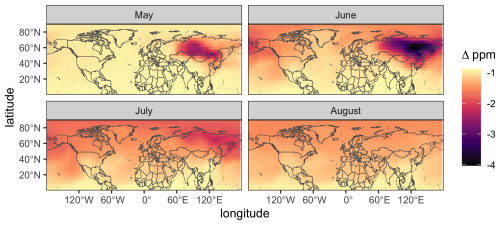
Figure 92D mixing ratio fields (integrated vertically up to an altitude of 400 m and averaged per month) when a delay of 10 d is prescribed to the CUPNEE onset in the Eurasian Boreal region. The field (Δ ppm) is the difference between the 2D mixing ratio fields when ΔCUPNEE is −10 and 0 d in experiment .
We show that, given fixed transport, the reduced expression of changes in CUPMR relative to CUPNEE arises from variations in the timing of CUPNEE across the regions over which the signal is integrated. For instance, when a delay (10 d) was applied to the CUPNEE onset in the Eurasian Boreal region, the mixing ratio reflects this change over the region in May and the signal slowly propagates eastward by June (Fig. 9), showing a difference in timing of the onset within the Eurasian Boreal region. The difference in the spatial distribution of CUPNEE onset, with an earlier CUPNEE onset in the western and later in the eastern part of the Eurasian Boreal region, is shown in Fig. 10. Due to the difference in CUPNEE timing across the pixels, the effective ΔCUPNEE of a region will be different from the applied Δ. The atmospheric transport does not always carry the CUPNEE fluxes from the region to the observation site; it could be transported in other directions at other times. If an applied Δ shifts the CUPNEE timing of some pixels into a period when transport is less favourable, the contribution from those pixels may be weaker or absent in the final measurements, causing a dampened relation between ΔCUPNEE and ΔCUPMR. Below, we discuss how the sensitivity of CUPMR to the discrete and long-term changes in surface fluxes is affected when influenced by the interannual variability in both transport and surface fluxes.

Figure 10Spatial distribution of the CUPNEE timing across the Northern Hemisphere as derived from Jena CarboScope CO2 Inversion (version ID: sEXTocNEET_v2021) NEE fluxes for the reference year (2003) used in the study.
4.1 Transport influence on CUPMR
We have shown the significant role of interannually varying atmospheric transport in the evaluation of metrics derived from CO2 mole fraction data. At certain sites such as ZEP and WIS, the CUPMR from simulations with fixed transport failed to capture the CUPNEE changes, whereas in simulations with varying transport, the prescribed CUPNEE changes could be partially derived from CUPMR. This indicates that in a given year of meteorology used in the fixed transport simulation, the atmospheric transport is unlikely to originate from the areas where the ΔCUPNEE was prescribed, while in simulations with transport variability, the meteorology in other years might have originated from these regions. Thus, the anomalies observed in CUPMR in a particular year could stem from transport variability rather than anomalies in CUPNEE itself, rendering mixing ratio time-series less useful for studying interannual variations in CUPNEE.
Finally, we show that due to the atmospheric transport, the source areas for a given station during the early and late CUPNEE phases can be substantially different, influencing the expression of CUPMR in the different CUPNEE phases. For instance, our analysis (Fig. 7) shows that WIS mainly receives signals from the Northern Hemisphere land pixels only in the late CUPNEE phase. Consequently, at WIS, the CUPMR is directly proportional solely to changes prescribed to late CUPNEE phase (slope of 0.5 in ). Similarly, at ZEP, the contribution of the Northern Hemisphere landmass to ΔCUPMR occurs only in the early CUPNEE phase. The atmospheric transport to ZEP is dominated by the regions Eurasian Boreal and Europe during March–May; in the following months (June–August), the air mass transport is largely confined to the Arctic and does not extend equatorward into the continents in some years (Tunved et al., 2013; Platt et al., 2022). Our observations imply that at ZEP/WIS, changes in the onset/termination of CUPNEE are more effectively reflected as changes in CUPMR.
4.2 Long-term trends in CUPMR
The long-term trends prescribed to the CUPNEE could be partially derived from CUPMR at BRW and SHM, even under IAV in atmospheric transport and CUPNEE. However, when IAV in CUPNEE was doubled, the prescribed trends were not captured. This suggests that the long-term trends in the observations may be compromised when there is a higher IAV in CUPNEE. The contribution from atmospheric transport exhibited a CUPMR trend of 0.11 d yr−1 at BRW. This finding aligns with a study by Murayama et al. (2007) where the IAV in transport alone caused a change of 0.16 d yr−1 in the downward zero-crossing date at BRW for their analysis period between 1979 and 1999.
With warming, a longer growing season is observed in the high latitudes (e.g., Park et al., 2016, 2.6 d per decade). A longer growing season does not necessarily mean an increase in CUPNEE or CUPMR as they are determined by both photosynthesis and respiration. The existing literature on the CUPNEE changes in the Northern Hemisphere based on CUPMR varies from increasing (Keeling et al., 1996) to neutral (Barichivich et al., 2012) to decreasing (Piao et al., 2008). The complications in interpreting CUPNEE changes arise mostly when directly assessing the CUP from CO2 mixing ratio. Therefore, CO2 observations should preferably be interpreted following a formal inverse estimate of the corresponding surface NEE. It is then possible to account for the interannual variability, trends, and delays imposed by the slow atmospheric mixing. Nevertheless, the ability of such inversions to constrain regional changes in NEE can only be improved with an expanded observation network.
4.3 Regional contribution to CUPMR
The regions contributing to the integrated signal at various observation sites are influenced by atmospheric transport to these locations. From the idealized simulations with no IAV in transport or CUPNEE it turned out that at sites like ALT, BRW, SHM, and MLO, a significant contribution from Boreal and Temperate regions could be calculated, indicating that these remote sites receive well-mixed signals from higher- and mid-latitude regions in the Northern Hemisphere with strong seasonality. We calculate that the contribution from mid-latitude is significant at the sites in the Boreal region (e.g., ALT and BRW in the early CUPNEE phase) in line with Barnes et al. (2016). They found that the seasonal cycle observed at higher latitude sites is most sensitive to changes in the seasonality of mid-latitude surface emissions; however, we do not find that the mid-latitude influence is more than the Boreal region influences at higher-latitude sites. At ZEP, strong signals from both Eurasian and North American regions dominate during the early CUPNEE phase (Fig. 7), and an amplification of the CUPMR signal is found. Further, a significant change in the regional contribution is found between the early and late CUPNEE phases, shifting from continental in the early CUPNEE phase to ocean signals in parts of the late CUPNEE phase (Sect. 4.1). This change explains the significant difference in ΔCUPMR to ΔCUPNEE during different phases, as shown in Fig. 4. At WIS, ASK, and AZR, when a delayed onset is imposed on the CUPNEE from Eurasian Boreal regions, a positive ΔCUPMR (i.e., an extension in CUPMR) is calculated. These sites are located in the temperate regions. The CO2 2D mixing ratio fields (Fig. 9) reveal that changes imposed on the Boreal region propagate partially to the lower latitudes (around 30° N) later in the CUPNEE phase. Thereby the delay imposed on the CUPNEE of the Eurasian Boreal region in May integrates at the lower latitude region (near to the location of WIS, ASK, and AZR) only later in July, delaying and extending the CUPMR.
When the long-term trends were applied to specific regions, the slope estimated from CUPMR had large uncertainty due to the influence of IAV in transport and CUPNEE. Furthermore, the flux manipulation strictly within the boundaries of the TransCom3 region in our experiments may have substantially limited the regions from which the signals reach the sites. In the real world, regional boundaries are more diffuse, and the footprint of the site provides a more accurate estimate of the regions contributing to the observed signals. Nonetheless, this aspect falls outside the scope of the present study.
The changes in the CO2 mixing ratio time series from the Northern Hemisphere give a larger spatial perspective of the CUPNEE changes. However, results from idealized simulations suggest that they are influenced by atmospheric transport IAV, seasonal changes in atmospheric transport, and IAV in the biospheric fluxes. We find a significant damping of the changes that were imposed on the CUPNEE from the integration of signals from different regions that have varied timing and suggest a more intense change in the local spatial scales. With the constraints in NEE flux manipulation, imposed by the presence of local maxima and insufficient data points for Δ changes in the early and late CUPNEE (Sect. 2.1), the simulations in this study do not accurately represent the real-world scenarios. In the real world, the changes in CUPNEE are asynchronous across space. Although we broadly examined the influence of different TransCom3 regions, conducting more dedicated footprint analyses of the studied sites may offer further insights into the signals studied here.
Our analysis, based on forward model experiments, reveals that at well-studied sites such as MLO, BRW, and ALT, only circa 50 % of the prescribed changes in the CUPNEE fluxes were reflected in CUPMR. In simulations with interannually varying meteorology, the signals were better captured at a few sites like ZEP and WIS, showing the significant influence of IAV in atmospheric transport. At BRW, 20 % of the observed trend could be attributed to the IAV in transport. Furthermore, our findings suggest that the changes estimated in CUPMR, subsequent to the separation of atmospheric transport influence, are likely to underestimate the actual magnitude of signals from the surface changes. This is because of the damping due to the integration of asynchronous CUPNEE timing across different regions. While sites like BRW and SHM partially captured the prescribed long-term changes in the presence of natural IAV, they proved insensitive when IAV in CUPNEE was doubled due to insufficient signal to noise. Furthermore, trends prescribed to individual TransCom3 regions were not captured by the evaluated sites, showing that long-term changes in the seasonal cycle of time series primarily reflect changes on larger spatial scales. These findings are based on forward model experiments rather than direct atmospheric observations, and they do not provide a direct estimate of biospheric changes. Instead, they highlight how atmospheric transport processes influence the representation of surface flux changes in CO2 observations.
Table A1Sensitivity of CUPMR to the applied long-term trend in CUPNEE for the different sites (excluding SHM and BRW). The first column shows the sites, the second column describes the prescribed trend applied to CUPNEE, and the other columns describe the different experiments, as detailed in the caption of Fig. 6. The values show the slope of the regression line fitted to the median CUPMR ±1 standard deviation (σ) around the estimated slope (in units of d yr−1) for the experiments indicated by the column names.
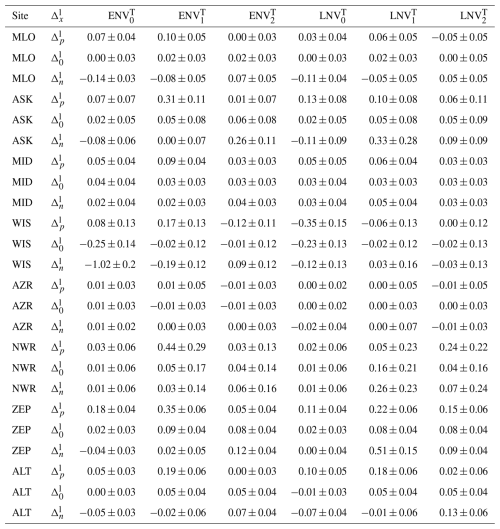
The NEE flux used here (Rödenbeck et al., 2003) is available from the Jena CarboScope website at https://doi.org/10.17871/CarboScope-sEXTocNEET_v2021 (Rödenbeck, 2021). The code used for manipulation of the flux is available from the corresponding author on request.
The coding and analysis were performed by TK with the contributions of JM. The study was conceptualized by JM, AB, and WP with contributions from MR. The original manuscript was drafted by TK, which was reviewed and edited by AB, WP, JM, and MR.
The contact author has declared that none of the authors has any competing interests.
Publisher's note: Copernicus Publications remains neutral with regard to jurisdictional claims made in the text, published maps, institutional affiliations, or any other geographical representation in this paper. While Copernicus Publications makes every effort to include appropriate place names, the final responsibility lies with the authors. Regarding the maps used in this paper, please note that Figs. 1, 3, 9, and 10 contain disputed territories.
We thank Christian Rödenbeck for providing access to the NEE flux data from the Jena CarboScope Inversion, as well as for his assistance in resolving queries related to running the TM3 transport model. We acknowledge the assistance of ChatGPT 3.5 for its support in refining the grammatical structure and phrasing of an earlier version of this publication.
The article processing charges for this open-access publication were covered by the Max Planck Society.
This paper was edited by Amos Tai and reviewed by three anonymous referees.
Barichivich, J., Briffa, K., Osborn, T., Melvin, T., and Caesar, J.: Thermal growing season and timing of biospheric carbon uptake across the Northern Hemisphere, Global Biogeochem. Cy., 26, GB4015, https://doi.org/10.1029/2012GB004312, 2012. a, b, c
Barichivich, J., Briffa, K. R., Myneni, R. B., Osborn, T. J., Melvin, T. M., Ciais, P., Piao, S., and Tucker, C.: Large-scale variations in the vegetation growing season and annual cycle of atmospheric CO2 at high northern latitudes from 1950 to 2011, Glob. Change Biol., 19, 3167–3183, https://doi.org/10.1111/gcb.12283, 2013. a
Barlow, J. M., Palmer, P. I., Bruhwiler, L. M., and Tans, P.: Analysis of CO2 mole fraction data: first evidence of large-scale changes in CO2 uptake at high northern latitudes, Atmos. Chem. Phys., 15, 13739–13758, https://doi.org/10.5194/acp-15-13739-2015, 2015. a
Barnes, E. A., Parazoo, N., Orbe, C., and Denning, A. S.: Isentropic transport and the seasonal cycle amplitude of CO2, J. Geophys. Res.-Atmos., 121, 8106–8124, https://doi.org/10.1002/2016JD025109, 2016. a
Buermann, W., Forkel, M., O'Sullivan, M., Sitch, S., Friedlingstein, P., Haverd, V., Jain, A. K., Kato, E., Kautz, M., Lienert, S., Lombardozzi, D., Nabel, J. E. M. S., Tian, H., Wiltshire, A. J., Zhu, D., Smith, W. K., and Richardson, A. D.: Widespread seasonal compensation effects of spring warming on northern plant productivity, Nature, 562, 110–114, https://doi.org/10.1038/s41586-018-0555-7, 2018. a
Churkina, G., Schimel, D., Braswell, B. H., and Xiao, X.: Spatial analysis of growing season length control over net ecosystem exchange, Glob. Change Biol., 11, 1777–1787, https://doi.org/10.1111/j.1365-2486.2005.001012.x, 2005. a, b
Ciais, P., Tan, J., Wang, X., Roedenbeck, C., Chevallier, F., Piao, S.-L., Moriarty, R., Broquet, G., Le Quéré, C., Canadell, J. G., Peng, S., Poulter, B., Liu, Z., and Tans, P.: Five decades of northern land carbon uptake revealed by the interhemispheric CO2 gradient, Nature, 568, 221–225, https://doi.org/10.1038/s41586-019-1078-6, 2019. a
Forkel, M., Carvalhais, N., Rödenbeck, C., Keeling, R., Heimann, M., Thonicke, K., Zaehle, S., and Reichstein, M.: Enhanced seasonal CO2 exchange caused by amplified plant productivity in northern ecosystems, Science, 351, 696–699, https://doi.org/10.1126/science.aac4971, 2016. a
Fu, Z., Stoy, P. C., Luo, Y., Chen, J., Sun, J., Montagnani, L., Wohlfahrt, G., Rahman, A. F., Rambal, S., Bernhofer, C., Wang, J., Shirkey, G., and Niu, S.: Climate controls over the net carbon uptake period and amplitude of net ecosystem production in temperate and boreal ecosystems, Agr. Forest Meteorol., 243, 9–18, https://doi.org/10.1016/j.agrformet.2017.05.009, 2017. a
Fu, Z., Stoy, P. C., Poulter, B., Gerken, T., Zhang, Z., Wakbulcho, G., and Niu, S.: Maximum carbon uptake rate dominates the interannual variability of global net ecosystem exchange, Glob. Change Biol., 25, 3381–3394, https://doi.org/10.1111/gcb.14731, 2019. a
Gill, A. L., Gallinat, A. S., Sanders-DeMott, R., Rigden, A. J., Short Gianotti, D. J., Mantooth, J. A., and Templer, P. H.: Changes in autumn senescence in northern hemisphere deciduous trees: a meta-analysis of autumn phenology studies, Ann. Bot., 116, 875–888, https://doi.org/10.1093/aob/mcv055, 2015. a
Gonsamo, A., Chen, J. M., Wu, C., and Dragoni, D.: Predicting deciduous forest carbon uptake phenology by upscaling FLUXNET measurements using remote sensing data, Agr. Forest Meteorol., 165, 127–135, https://doi.org/10.1016/j.agrformet.2012.06.006, 2012. a, b
Graven, H. D., Keeling, R. F., Piper, S. C., Patra, P. K., Stephens, B. B., Wofsy, S. C., Welp, L. R., Sweeney, C., Tans, P. P., Kelley, J. J., Daube, B. C., Kort, E. A., Santoni, G. W., and Bent, J. D.: Enhanced seasonal exchange of CO2 by northern ecosystems since 1960, Science, 341, 1085–1089, https://doi.org/10.1126/science.1239207, 2013. a
Gurney, K. R., Law, Rachel M.and Denning, A. S. R. P. J. B. D., Bousquet, P., Bruhwiler, L., Chen, Y.-H., Ciais, P., Fan, S., Fung, I. Y., Gloor, M., Heimann, M., Higuchi, K., John, J., Maki, T., Maksyutov, S., Masarie, K., Peylin, P., Prather, M., Pak, B. C., Randerson, J., Sarmiento, J., Taguchi, S., Takahashi, T., and Yuen, C.-W.: Towards robust regional estimates of CO2 sources and sinks using atmospheric transport models, Nature, 415, 626–630, https://doi.org/10.1038/415626a, 2002. a, b
Heimann, H. and Körner, S.: The global atmospheric tracer model TM3, Technical Reports – Max-Planck-Institut für Biogeochemie 5, p. 131, https://www.bgc-jena.mpg.de/archived/bgc-systems/bgc-systems/uploads/Publications/5.pdf (last access: 3 July 2025), 2003. a, b, c
Jin, Y., Keeling, R. F., Rödenbeck, C., Patra, P. K., Piper, S. C., and Schwartzman, A.: Impact of Changing Winds on the Mauna Loa CO2 Seasonal Cycle in Relation to the Pacific Decadal Oscillation, J. Geophys. Res.-Atmos., 127, e2021JD035892, https://doi.org/10.1029/2021JD035892, 2022. a
Jung, M., Schwalm, C., Migliavacca, M., Walther, S., Camps-Valls, G., Koirala, S., Anthoni, P., Besnard, S., Bodesheim, P., Carvalhais, N., Chevallier, F., Gans, F., Goll, D. S., Haverd, V., Köhler, P., Ichii, K., Jain, A. K., Liu, J., Lombardozzi, D., Nabel, J. E. M. S., Nelson, J. A., O'Sullivan, M., Pallandt, M., Papale, D., Peters, W., Pongratz, J., Rödenbeck, C., Sitch, S., Tramontana, G., Walker, A., Weber, U., and Reichstein, M.: Scaling carbon fluxes from eddy covariance sites to globe: synthesis and evaluation of the FLUXCOM approach, Biogeosciences, 17, 1343–1365, https://doi.org/10.5194/bg-17-1343-2020, 2020. a
Kariyathan, T., Bastos, A., Marshall, J., Peters, W., Tans, P., and Reichstein, M.: Reducing errors on estimates of the carbon uptake period based on time series of atmospheric CO2, Atmos. Meas. Tech., 16, 3299–3312, https://doi.org/10.5194/amt-16-3299-2023, 2023. a, b, c, d, e
Keeling, C. D., Chin, J. F. S., and Whorf, T. P.: Increased activity of northern vegetation inferred from atmospheric CO2 measurements, Nature, 382, 146–149, 1996. a, b, c
Lintner, B. R., Buermann, W., Koven, C. D., and Fung, I. Y.: Seasonal circulation and Mauna Loa CO2 variability, J. Geophys. Res.-Atmos., 111, D13104, https://doi.org/10.1029/2005JD006535, 2006. a
Murayama, S., Higuchi, K., and Taguchi, S.: Influence of atmospheric transport on the inter-annual variation of the CO2 seasonal cycle downward zero-crossing, Geophys. Res. Lett., 34, L04811, https://doi.org/10.1029/2006GL028389, 2007. a, b, c, d
Park, T., Ganguly, S., Tømmervik, H., Euskirchen, E. S., Høgda, K.-A., Karlsen, S. R., Brovkin, V., Nemani, R. R., and Myneni, R. B.: Changes in growing season duration and productivity of northern vegetation inferred from long-term remote sensing data, Environ. Res. Lett., 11, 084001, https://doi.org/10.1088/1748-9326/11/8/084001, 2016. a
Piao, S., Ciais, P., Friedlingstein, P., Peylin, P., Reichstein, M., Luyssaert, S., Margolis, H., Fang, J., Barr, A., Chen, A., Grelle, A., Hollinger, D., Laurila, T., Lindroth, A., Richardson, A., and Vesala, T.: Net carbon dioxide losses of northern ecosystems in response to autumn warming, Nature, 451, 49–52, https://doi.org/10.1038/nature06444, 2008. a, b, c, d, e, f
Piao, S., Liu, Z., Wang, T., Peng, S., Ciais, P., Huang, M., Ahlstrom, A., Burkhart, J. F., Chevallier, F., Janssens, I. A., Jeong, S.-J., Lin, X., Mao, J., Miller, J., Mohammat, A., Myneni, R. B., Peñuelas, J., Shi, X., Stohl, A., Yao, Y., Zhu, Z., and Tans, P. P.: Weakening temperature control on the interannual variations of spring carbon uptake across northern lands, Nat. Clim. Change, 7, 359–363, https://doi.org/10.1038/nclimate3277, 2017. a
Piao, S., Liu, Q., Chen, A., Janssens, I. A., Fu, Y., Dai, J., Liu, L., Lian, X., Shen, M., and Zhu, X.: Plant phenology and global climate change: Current progresses and challenges, Glob. Change Biol., 25, 1922–1940, https://doi.org/10.1111/gcb.14619, 2019. a, b
Platt, S. M., Hov, Ø., Berg, T., Breivik, K., Eckhardt, S., Eleftheriadis, K., Evangeliou, N., Fiebig, M., Fisher, R., Hansen, G., Hansson, H.-C., Heintzenberg, J., Hermansen, O., Heslin-Rees, D., Holmén, K., Hudson, S., Kallenborn, R., Krejci, R., Krognes, T., Larssen, S., Lowry, D., Lund Myhre, C., Lunder, C., Nisbet, E., Nizzetto, P. B., Park, K.-T., Pedersen, C. A., Aspmo Pfaffhuber, K., Röckmann, T., Schmidbauer, N., Solberg, S., Stohl, A., Ström, J., Svendby, T., Tunved, P., Tørnkvist, K., van der Veen, C., Vratolis, S., Yoon, Y. J., Yttri, K. E., Zieger, P., Aas, W., and Tørseth, K.: Atmospheric composition in the European Arctic and 30 years of the Zeppelin Observatory, Ny-Ålesund, Atmos. Chem. Phys., 22, 3321–3369, https://doi.org/10.5194/acp-22-3321-2022, 2022. a
Rödenbeck, C.: Atmospheric CO2 Inversion, 1957–2020, Jena CarboScope [data set], https://doi.org/10.17871/CarboScope-sEXTocNEET_v2021, 2021. a
Rödenbeck, C., Houweling, S., Gloor, M., and Heimann, M.: CO2 flux history 1982–2001 inferred from atmospheric data using a global inversion of atmospheric transport, Atmos. Chem. Phys., 3, 1919–1964, https://doi.org/10.5194/acp-3-1919-2003, 2003. a, b, c
Shen, M., Wang, S., Jiang, N., Sun, J., Cao, R., Ling, X., Fang, B., Zhang, L., Zhang, L., Xu, X., Lv, W., Li, B., Sun, Q., Meng, F., Jiang, Y., Dorji, T., Fu, Y., Iler, A., Vitasse, Y., Steltzer, H., Ji, Z., Zhao, W., Piao, S., and Fu, B.: Plant phenology changes and drivers on the Qinghai–Tibetan Plateau, Nature Reviews Earth & Environment, 3, 633–651, https://doi.org/10.1038/s43017-022-00317-5, 2022. a
Tunved, P., Ström, J., and Krejci, R.: Arctic aerosol life cycle: linking aerosol size distributions observed between 2000 and 2010 with air mass transport and precipitation at Zeppelin station, Ny-Ålesund, Svalbard, Atmos. Chem. Phys., 13, 3643–3660, https://doi.org/10.5194/acp-13-3643-2013, 2013. a
van der Woude, A. M., Peters, W., Joetzjer, E., Lafont, S., Koren, G., Ciais, P., Ramonet, M., Xu, Y., Bastos, A., Botía, S., Sitch, S., de Kok, R., Kneuer, T., Kubistin, D., Jacotot, A., Loubet, B., Herig-Coimbra, P.-H., Loustau, D., and Luijkx, I. T.: Temperature extremes of 2022 reduced carbon uptake by forests in Europe, Nat. Commun., 14, 6218, https://doi.org/10.1038/s41467-023-41851-0, 2023. a
Walther, S., Besnard, S., Nelson, J. A., El-Madany, T. S., Migliavacca, M., Weber, U., Carvalhais, N., Ermida, S. L., Brümmer, C., Schrader, F., Prokushkin, A. S., Panov, A. V., and Jung, M.: Technical note: A view from space on global flux towers by MODIS and Landsat: the FluxnetEO data set, Biogeosciences, 19, 2805–2840, https://doi.org/10.5194/bg-19-2805-2022, 2022. a
Wang, X., Sun, Z., Lu, S., and Zhang, Z.: Comparison of Phenology Estimated From Monthly Vegetation Indices and Solar-Induced Chlorophyll Fluorescence in China, Front. Earth Sci., 10, 802763, https://doi.org/10.3389/feart.2022.802763, 2022. a
Zeng, L., Wardlow, B. D., Xiang, D., Hu, S., and Li, D.: A review of vegetation phenological metrics extraction using time-series, multispectral satellite data, Remote Sens. Environ., 237, 111511, https://doi.org/10.1016/j.rse.2019.111511, 2020. a
Zhou, X., Geng, X., Yin, G., Hänninen, H., Hao, F., Zhang, X., and Fu, Y. H.: Legacy effect of spring phenology on vegetation growth in temperate China, Agr. Forest Meteorol., 281, 107845, https://doi.org/10.1016/j.agrformet.2019.107845, 2020. a
Zhu, W., Tian, H., Xu, X., Pan, Y., Chen, G., and Lin, W.: Extension of the growing season due to delayed autumn over mid and high latitudes in North America during 1982–2006, Global Ecol. Biogeogr., 21, 260–271, https://doi.org/10.1111/j.1466-8238.2011.00675.x, 2012. a, b





